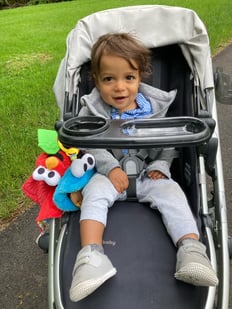Fatherhood: the Great Disruptor.
Co-founder and CEO of Babyscripts Anish Sebastian shares his family’s birth journey, and how it's motivated his work in the maternity care space.
In the early days of Babyscripts, the Washington Post ran an article about me and my startup co-founder titled “How two bachelors teamed up to transform the maternity care experience.”
Fast forward to the present day — I’m no longer a bachelor; and my life changed forever when my wife gave birth to our baby son, Lazarus.
In that moment, the tables had completely turned. The maternity care experience had transformed me. I’m looking back on the lessons that I’ve learned from fatherhood, and how it’s informed and shaped the way I approach my work with Babyscripts.
 Ultimately, it brought home two things (in addition to my new homie, Laz, obviously): it validated everything I do with my maternity care startup, and second, it confirmed how much work and improvement there is still to do.
Ultimately, it brought home two things (in addition to my new homie, Laz, obviously): it validated everything I do with my maternity care startup, and second, it confirmed how much work and improvement there is still to do.
The system needs an overhaul. The color of someone’s skin, the neighborhood they live in, the job they have (or don’t) — these things should not determine the kind of maternity care a woman receives, or if they know where and how to seek it out.
In the US, where the maternal mortality and morbidity rate is the highest in the developed world, many complications happen outside of the traditional timeframe of maternity care.
We need to offer holistic maternal healthcare that starts before a woman even gets pregnant and continues to support her through the whole of the postpartum period. Maternal healthcare is women’s healthcare — and it needs to go far beyond the delivery of a healthy baby.
Covid impacted everything, and the pregnancy journey was no exception
When my wife and I made our plans to move to Manhattan and have a baby, we imagined it going differently. Long walks in Central Park, running to the corner bodega for late night cravings, exploring the city for the best bagels and schmear after OB appointments — we were hoping for Nora Ephron, instead we got Steven Soderbergh.
Covid forced us to put aside every expectation we had about becoming parents.
 Because of restricted visitor policies, my wife had to go to her prenatal appointments by herself — and I missed all of the sentimental milestones.
Because of restricted visitor policies, my wife had to go to her prenatal appointments by herself — and I missed all of the sentimental milestones.
A few telemedicine-based appointments made up for some of that disappointment — while they could not replace the experience of being in-person, they were highly effective, and there was a comfort in being able to share those meaningful moments from our home.
Covid also threw us a massive curveball in the form of the vaccine — specifically, whether pregnant moms should take it or not. Even with our combined experience in healthcare (my wife is an ob/gyn), it was still a difficult decision. My wife ultimately decided that she would receive the vaccine, but it brought home to us how others were struggling with the same decisions and fears, without the benefit of our experience.
Using digital health during pregnancy
The vaccine dilemma was just one of the many steps in the pregnancy process that affirmed the importance of trusted resources. Fortunately, we both know how to find those resources, but realize that many women throw themselves on the mercies of the fickle and often inaccurate Dr. Google.
While there are endless pregnancy apps in the app store (and we did download a bunch), they didn’t provide us any clinical guidance.
While our doctors were amazing, we also felt an absence on their end for resources. The over-reliance on paper resources and the occasional nudge to MyChart felt a bit outdated, especially as new information on Covid was emerging every day.
Obviously, given my work in digital health and my wife’s clinical background, we were eager to try out some tech toys. Here’s where we landed on that:
What we’d do again: At-home blood pressure monitoring.
In my work at a maternity care startup, I’ve seen the importance of continuous BP monitoring, and now I’ve seen its benefits firsthand. We used an at-home BP cuff to check my wife’s BP routinely during pregnancy and postpartum, giving us reassurance and keeping us engaged.
What we’d skip next time: Fetal heart rate monitor.
We used an at-home FHTs monitor, but found it to be less than helpful. Even with my wife operating it, it registered a lot of false positives and ultimately just created unnecessary stress for both of us. I remember a late-night panic when we couldn’t get the heartbeat of the baby — thankfully, my wife was far enough along that we could feel the baby kick.
While I remain convinced that if implemented properly (i.e with clinical monitoring), use of at-home FHTs can be valuable, the tools today aren’t there yet.



Becoming a family of three and learning my privilege
Having a baby turns your world upside down — and pretty much everything gets pushed out of your brain. But in between the diapers and sleepless nights, one thing did manage to stick in my brain, and that was how much harder this would be if I were someone else.
Someone who isn’t the husband of an ob/gyn or the head of a maternity care company. Someone who isn’t fortunate enough to have good insurance coverage — someone who doesn’t have access to some of the world's best experts in pregnancy and state-of-the-art clinical protocols and tooling.
Even with all of this — and our Type-A personalities that had everything planned down to the last safety pin — we were completely overwhelmed and underprepared for having a child.
Imagine that we didn’t have the connections, the knowledge that we do, proper access to care — imagine that we didn’t have each other! With every hypothetical I considered, my advantage was more firmly brought home to me.
The challenges we faced as two adults parenting a single baby, with all our time focused on that one task, felt insurmountable.
And yet moms are facing those same challenges every day with less support and more obstacles. A huge percentage of new moms lack adequate leave, a supportive partner and community, stable housing, job security, a safe domestic life — and a lot of them are juggling more than one child.
As an immigrant from a minority community, I’m especially sensitive to the fact that these challenges disproportionately affect people of color and immigrants. Give a baby into the hands of the most secure individual, and they’ll struggle to adjust their life to this new entity — add systemic racism and structural inequity to the mix, and they’re likely to collapse.
Back to work, with a new perspective
My experience becoming a father (and everything that entails — hey there, 3 am! Been a long time since I’ve seen you) has renewed my drive to provide better pregnancy care and support for moms, and revealed to me just how much the opportunity varies across populations.
We need to level the barriers that keep women from accessing quality care and innovative solutions — reduce stigma and combat structural racism — educate women in their own health and wellness — and make sure that no financial barriers keep women back from the best in maternity care.
We have a lot to do. I’m getting back to work.

Submit a comment